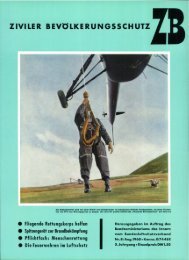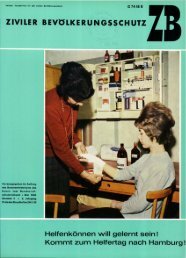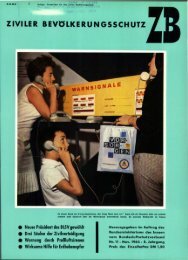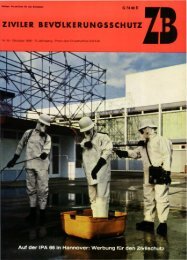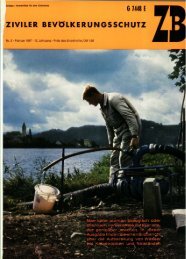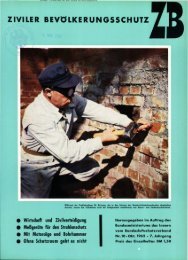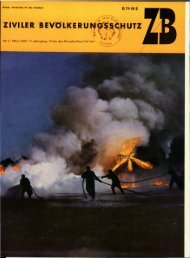Zivilschutz- Forschung - Bundesverwaltungsamt
Zivilschutz- Forschung - Bundesverwaltungsamt
Zivilschutz- Forschung - Bundesverwaltungsamt
Erfolgreiche ePaper selbst erstellen
Machen Sie aus Ihren PDF Publikationen ein blätterbares Flipbook mit unserer einzigartigen Google optimierten e-Paper Software.
Abstract<br />
Decontamination and Treatment of Injured Persons during Chemical Agent<br />
Incidents<br />
Domres, Bernd; Manger, Andreas; Brockmann, Stefan; Wenke, Rainer<br />
Introduction: The conception of a Medical incident response plan for the<br />
treatment of injured persons who have been contaminated during a chemical<br />
incident challenges more than one of the rescue services involved in civil<br />
emergency response. Our main objective in this project was the creation of an<br />
incident management plan compatible with existing rescue service logistics and<br />
resources that can be quickly and efficiently activated at a local level.<br />
Methods: Under the supervision of the Schutzkommission des Inneren and<br />
together with delegates from EMS, fire, technical rescue services and the German<br />
army a consensus conferences to investigate the general conditions necessary and<br />
the existing structure available for managing victims of chemical incidents, was<br />
created. Research of existing literature, and an analysis of past incidents lead to<br />
the development of this concept. Typical injury patterns and their treatment in<br />
respect to decontamination procedures were considered, the necessary structure for<br />
casualty treatment and decontamination areas were then derived and commercially<br />
available products were tested for their usefulness in this situation. Standard<br />
operating procedures and algorithms were developed to aid realization of the<br />
concept. The suitability of the personal protective equipment and the question, if<br />
under these conditions the procedures of Advanced Life Support can be performed,<br />
was evaluated in a standardized simulator model. The necessary training for rescue<br />
personnel involved was defined. To validate the concept, an exercise was carried<br />
out.<br />
Results: All persons present at a chemical incident are to be classified as being<br />
contaminated. Injured persons must be separated into triage categories, and life<br />
threatening conditions treated before being decontaminated. Decontamination at<br />
the incident scene is necessary to prevent the transportation of the contaminant<br />
away from the incident scene. The principles of the Decontamination of injured<br />
persons are based on the following pillars: Triage, early removal of clothing,<br />
Management of personal belongings and valuables, Basic Life Support, Spot<br />
Decontamination, management and sealing of open wounds, application of<br />
antidotes, and primary decontamination of ambulant and non-ambulant victims.<br />
The co-operation and the definition of roles between fire service (decontamination)<br />
and Emergency Medical Services (triage and treatment) is necessary.<br />
The concept uses existing decontamination vehicles used for the decontamination<br />
of fire fighters, by expanding it inventory with medical equipment, and extra<br />
technical apparatus. Using a modular approach, the system can be easily added to<br />
by further units to treat multiple numbers of victims. However, demands on all<br />
7




